Aston University, Birmingham (ASTON)
Latest uploads at Aston University, Birmingham (ASTON). Looking for notes at Aston University, Birmingham (ASTON)? We have lots of notes, study guides and study notes available for your school.
-
469
-
4
-
24
Majors at Aston University, Birmingham (ASTON)
Notes available for the following studies at Aston University, Birmingham (ASTON)
-
Aston University, Birmingham 113
-
Economics 1
-
International Business 1
Latest notes & summaries Aston University, Birmingham (ASTON)
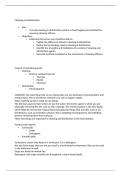
• Aim – To study cleaning & disinfection practice in food hygiene and methods for assessing cleaning efficacy. • Objectives – Following this lecture you should be able to: • Explain the difference between cleaning & disinfection. • Define the terminology used in cleaning & disinfection. • Identify the strengths and limitations of a variety of cleaning and disinfection agents. • Describe methods available for the assessment of cleaning efficacy.
- Package deal
- Class notes
- • 11 pages's •
-
Aston University, Birmingham•clinical and food microbiology BM6CFM
-
clinical and food microbiology lecture 1-16• Bysarah21jan
Preview 2 out of 11 pages
• Aim – To study cleaning & disinfection practice in food hygiene and methods for assessing cleaning efficacy. • Objectives – Following this lecture you should be able to: • Explain the difference between cleaning & disinfection. • Define the terminology used in cleaning & disinfection. • Identify the strengths and limitations of a variety of cleaning and disinfection agents. • Describe methods available for the assessment of cleaning efficacy.
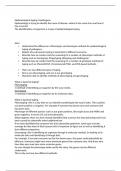
• Understand the difference in Phenotypic and Genotypic methods for epidemiological typing of pathogens. • Explain why sub-species typing is important in different scenarios. • Describe how to conduct and the reasoning for a number of phenotypic methods of typing such as: Serotyping, Phagetyping, Biotyping and Anitbiogram. • Describe how to conduct and the reasoning for a number of genotypic methods of typing such as: Plasmid RFLP, Chromosomal PFGE, and PCR-based methods. • T...
- Package deal
- Class notes
- • 9 pages's •
-
Aston University, Birmingham•clinical and food microbiology BM6CFM
-
clinical and food microbiology lecture 1-16• Bysarah21jan
Preview 2 out of 9 pages
• Understand the difference in Phenotypic and Genotypic methods for epidemiological typing of pathogens. • Explain why sub-species typing is important in different scenarios. • Describe how to conduct and the reasoning for a number of phenotypic methods of typing such as: Serotyping, Phagetyping, Biotyping and Anitbiogram. • Describe how to conduct and the reasoning for a number of genotypic methods of typing such as: Plasmid RFLP, Chromosomal PFGE, and PCR-based methods. • T...
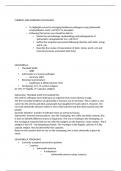
– To highlight current & emerging foodborne pathogens using Salmonella Campylobacter and E. coli O157 as examples. – Following this lecture you should be able to: • Relate the microbiology, epidemiology and pathogenicity of Salmonella, Campylobacter & E. coli O157. • Define the symptoms presented following infection with Salm. Camp. and E. coli. • Describe the routes of transmission of Salm. Camp. and E. coli and how they become associated with food.
- Package deal
- Class notes
- • 20 pages's •
-
Aston University, Birmingham•clinical and food microbiology BM6CFM
-
clinical and food microbiology lecture 1-16• Bysarah21jan
Preview 3 out of 20 pages
– To highlight current & emerging foodborne pathogens using Salmonella Campylobacter and E. coli O157 as examples. – Following this lecture you should be able to: • Relate the microbiology, epidemiology and pathogenicity of Salmonella, Campylobacter & E. coli O157. • Define the symptoms presented following infection with Salm. Camp. and E. coli. • Describe the routes of transmission of Salm. Camp. and E. coli and how they become associated with food.
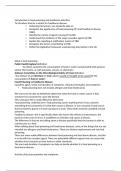
To introduce food as a vehicle for foodborne disease. • Following this lecture, you should be able to: • Recognise the significance of food poisoning (FP) and foodborne disease (FBD). • Identify the variety of agents causing FP & FBD. • Understand the incidence of the major causative agents of FBD • Explain the reporting & notification system of FBD. • Recognise the factors contributing to FBD. • Define the legislative framework underpinning food safety in the UK.
- Package deal
- Class notes
- • 8 pages's •
-
Aston University, Birmingham•clinical and food microbiology BM6CFM
-
clinical and food microbiology lecture 1-16• Bysarah21jan
Preview 2 out of 8 pages
To introduce food as a vehicle for foodborne disease. • Following this lecture, you should be able to: • Recognise the significance of food poisoning (FP) and foodborne disease (FBD). • Identify the variety of agents causing FP & FBD. • Understand the incidence of the major causative agents of FBD • Explain the reporting & notification system of FBD. • Recognise the factors contributing to FBD. • Define the legislative framework underpinning food safety in the UK.
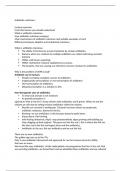
From this lecture you should understand What is antibiotic resistance How antibiotic resistance emerges Main mechanisms of antibiotic resistance and suitable examples of each Difference between adaptive and mutational resistance What is antibiotic resistance. • The ability of bacteria to survive treatment by certain antibiotics. • Bacteria which are resistant to multiple antibiotics are called multi-drug resistant bacteria • MSRA- well known superbug. • MSRA- methycline re...
- Package deal
- Class notes
- • 11 pages's •
-
Aston University, Birmingham•clinical and food microbiology BM6CFM
-
clinical and food microbiology lecture 1-16• Bysarah21jan
Preview 2 out of 11 pages
From this lecture you should understand What is antibiotic resistance How antibiotic resistance emerges Main mechanisms of antibiotic resistance and suitable examples of each Difference between adaptive and mutational resistance What is antibiotic resistance. • The ability of bacteria to survive treatment by certain antibiotics. • Bacteria which are resistant to multiple antibiotics are called multi-drug resistant bacteria • MSRA- well known superbug. • MSRA- methycline re...
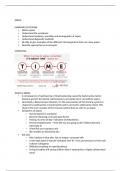
• Define sepsis • Understand the symptoms • Understand incidence, mortality and demographic of sepsis • Understand diagnostic methods • Be able to give examples of the different microorganisms that can cause sepsis • Describe approaches to treat sepsis
- Package deal
- Class notes
- • 7 pages's •
-
Aston University, Birmingham•clinical and food microbiology
-
clinical and food microbiology lecture 1-16• Bysarah21jan
Preview 2 out of 7 pages
• Define sepsis • Understand the symptoms • Understand incidence, mortality and demographic of sepsis • Understand diagnostic methods • Be able to give examples of the different microorganisms that can cause sepsis • Describe approaches to treat sepsis

• Define gastrointestinal infection • Clostridium difficile Associated Disease (CDAD) - Epidemiology; risk factors for CDAD - Pathogenesis / C. difficile ribotype 027 - Clinical manifestations of CDAD - Laboratory diagnosis (culture / non-culture) - Treatment and prevention
- Package deal
- Class notes
- • 12 pages's •
-
Aston University, Birmingham•clinical and food microbiology
-
clinical and food microbiology lecture 1-16• Bysarah21jan
Preview 2 out of 12 pages
• Define gastrointestinal infection • Clostridium difficile Associated Disease (CDAD) - Epidemiology; risk factors for CDAD - Pathogenesis / C. difficile ribotype 027 - Clinical manifestations of CDAD - Laboratory diagnosis (culture / non-culture) - Treatment and prevention
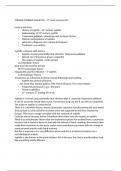
• History of syphilis - 21st century syphilis • Epidemiology of 21st century syphilis • Treponema pallidum –physiology and virulence factors • Clinical manifestations of syphilis • Laboratory diagnosis (non culture techniques) • Treatment / prevention
- Package deal
- Class notes
- • 11 pages's •
-
Aston University, Birmingham•clinical and food microbiology
-
clinical and food microbiology lecture 1-16• Bysarah21jan
Preview 2 out of 11 pages
• History of syphilis - 21st century syphilis • Epidemiology of 21st century syphilis • Treponema pallidum –physiology and virulence factors • Clinical manifestations of syphilis • Laboratory diagnosis (non culture techniques) • Treatment / prevention
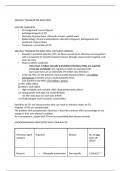
LECTURE OVERVIEW. • STI background; current figures • Aetiological agents of STI • Overview of gonorrhoea, chlamydia, herpes, genital warts • Epidemiology, clinical manifestations, laboratory diagnosis, pathogenesis and treatment of gonorrhoea • Treatment / prevention of STI
- Package deal
- Class notes
- • 12 pages's •
-
Aston University, Birmingham•clinical and food microbiology
-
clinical and food microbiology lecture 1-16• Bysarah21jan
Preview 2 out of 12 pages
LECTURE OVERVIEW. • STI background; current figures • Aetiological agents of STI • Overview of gonorrhoea, chlamydia, herpes, genital warts • Epidemiology, clinical manifestations, laboratory diagnosis, pathogenesis and treatment of gonorrhoea • Treatment / prevention of STI
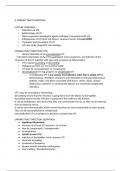
• Definitions of UTI • Epidemiology of UTI • Micro-organisms (aetiological agents/pathogens) associated with UTI • Pathogenesis of UTI (host risk factors; virulence factors of E.coli (UPEC) • Treatment and prevention of UTI • UTI case study: diagnostic microbiology
- Package deal
- Class notes
- • 12 pages's •
-
Aston University, Birmingham•clinical and food microbiology
-
clinical and food microbiology lecture 1-16• Bysarah21jan
Preview 2 out of 12 pages
• Definitions of UTI • Epidemiology of UTI • Micro-organisms (aetiological agents/pathogens) associated with UTI • Pathogenesis of UTI (host risk factors; virulence factors of E.coli (UPEC) • Treatment and prevention of UTI • UTI case study: diagnostic microbiology
